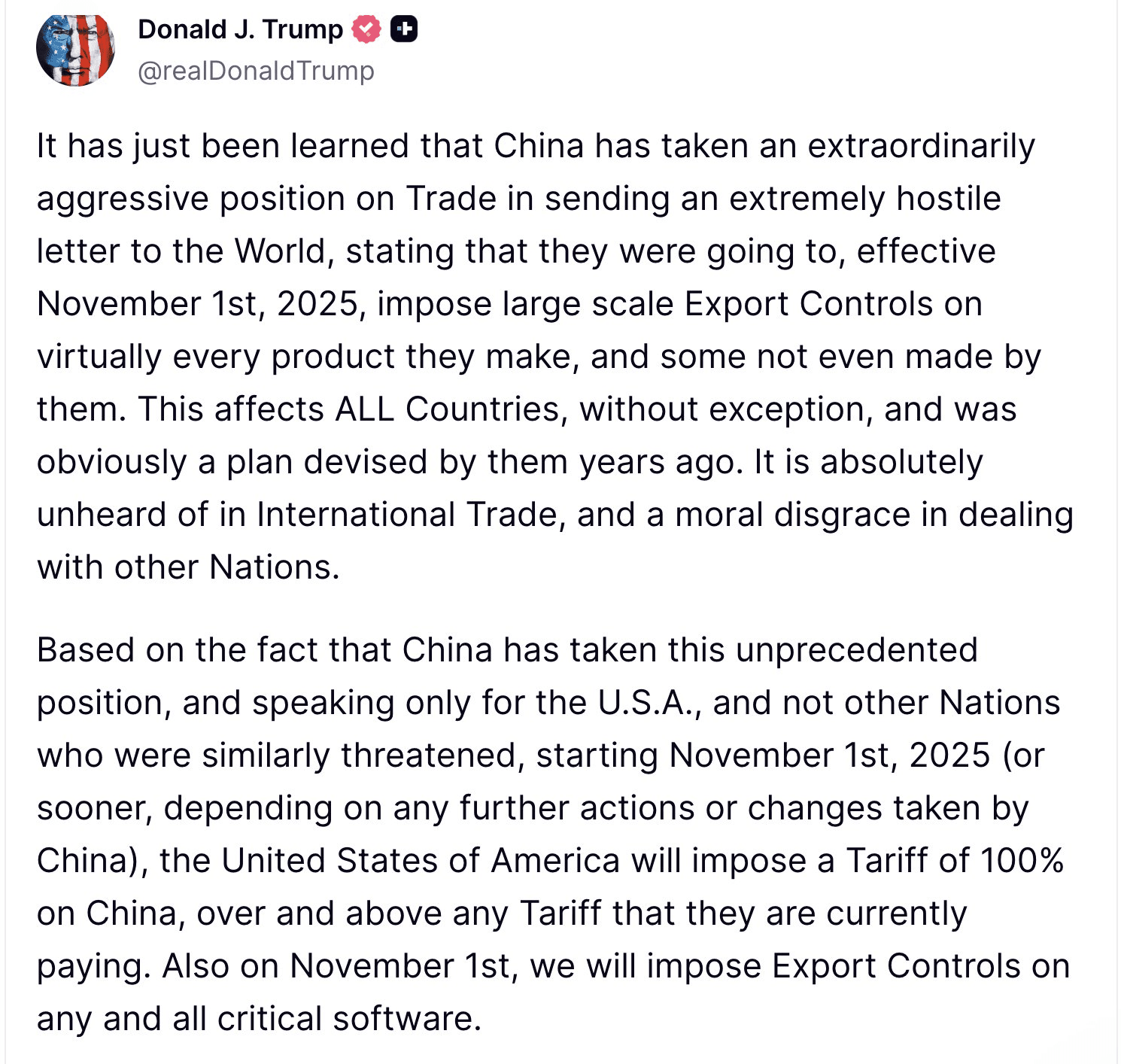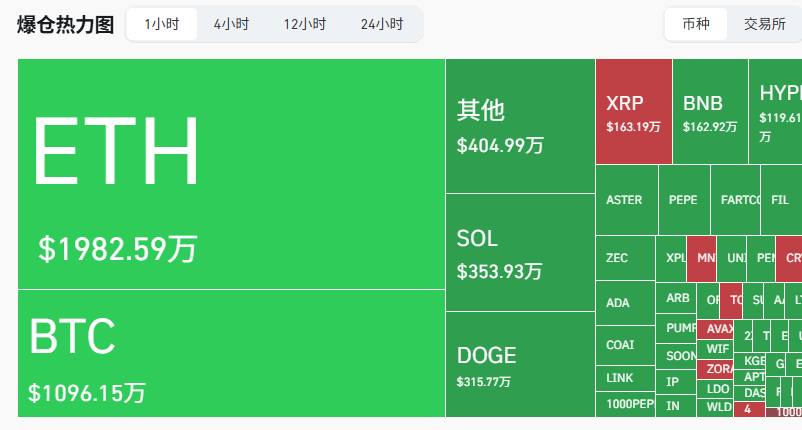A financial storm ignited by political rhetoric made over 1.6 million traders experience the brutal aesthetics of leveraged trading in just 24 hours.
A statement by Trump on social media triggered a chain reaction in global financial markets. On October 10, Trump threatened to impose a '100% tariff' on Chinese imports, a move that not only shocked traditional stock markets but also triggered an epic crash in the cryptocurrency market.
Bitcoin has been continuously falling without resistance at an average rate of nearly 1% per minute over 30 minutes, with the most extreme moment seeing a drop of over 4% in one minute, falling nearly $5,000, ultimately plummeting to $102,000.

01 Tariff Black Swan
Trump made a statement on Truth Social on October 10, threatening to impose 'huge tariffs' on Chinese goods entering the U.S., and later confirmed that the tariff rate would be raised to 100%.
This sudden re-initiation of the trade war stemmed from China's export control measures on rare earth metals, while Trump's response dropped a 'macro shock bomb' on the global financial markets.
Trump stated in the announcement: 'Ultimately, although it may be painful, this will ultimately be very good for the United States. One policy we are calculating is to significantly raise tariffs on Chinese goods entering the United States.'
After this announcement, global risk assets instantly reversed their previous trends, entering a mode of indiscriminate crashing.
02 Cryptocurrency Slaughter
Bitcoin began to plummet from around $122,000 on the evening of October 10, eventually falling below $102,000, with a single-day decline of over 12%.
The declines in other major cryptocurrencies were even more severe. Ethereum and Solana both fell nearly 5%, with prices dropping to $4,107 and $211, respectively.
The altcoin market is bleeding heavily. SUI plummeted from $3.5 to $0.55; WLD fell from $1.4 to $0.26; even Dogecoin, which is among the top ten by market capitalization, experienced a 50% drop.
An anonymous whale opened a short position of $1.1 billion with $30 million before the crash, taking profit at the peak of the disaster and doubling the principal in less than 20 hours, quickly exiting with $60 million.
03 Liquidation Data Hits Record
According to CoinGlass statistics, the total liquidation amount in the cryptocurrency market reached $8.02 billion in the past 24 hours, with Bitcoin alone accounting for $2.19 billion.
This event, referred to by the market as the '1011 Crash,' led to over 1.6 million traders being liquidated, with each figure setting a historical record for cryptocurrency contract trading in the past decade.
Data shows that in just the past hour when the crash was most severe, the total liquidation amount reached $459 million, with the vast majority being long positions.
Even CoinGlass.com's liquidation page crashed due to excessive traffic, and by Friday afternoon, over $250 billion had evaporated from the crypto economy.
04 Traditional Market Resonance
The panic triggered by tariffs similarly swept through traditional financial markets.
As of Friday, the Nasdaq index fell by 1.77%, the S&P 500 index fell by 1.25%, and the Dow Jones index fell by 0.83%.
Even more startling is that, according to the Kobeissi Letter, after Trump announced tariff news at 10:57 AM, the S&P 500 index lost about $700 billion in market value within just 3 minutes, indicating the vulnerability of risk assets in the face of such macro events.
The Hang Seng Index futures fell 5% in the night session, and the FTSE A50 index futures fell 4.26% in a row during the night session, showing characteristics of global markets collectively falling into panic.
05 Market Mechanism Analysis
Swan Bitcoin CEO Cory Klippsten pointed out that this price crash primarily stemmed from 'macro issues triggering leveraged position liquidations and weak buying.'
During the crash, market liquidity plummeted sharply, almost creating a scenario of uncontested decline.
Cointelegraph market department analyst Ray Salmond added: 'Trump's tariff policy news had a significant impact on the market, especially for leveraged traders who were almost caught off guard.'
This macro shock effect is accelerated through emotional transmission and leveraged liquidation, forming a typical death spiral, causing the entire market to lose its price discovery function in a short time.
06 Historical Comparison
This is not the first time Trump's tariff war has affected the market.
As early as April this year, Trump's comprehensive 'Liberation Day' tariffs imposed on 185 countries caused Bitcoin to drop 1.1% within an hour, while the S&P 500 index lost over $2 trillion in market value in just 15 minutes.
Since then, the relationship between the president and tariffs has been fluctuating, with regular adjustments to tariffs on multiple countries and economic groups (including China).
However, unlike before, the magnitude of this tariff threat is greater— a 100% tariff rate far exceeds the tariff levels in any previous trade war, which is also a key reason for the market's intense reaction.
Historically, the trade war from 2018-2019 also caused severe market fluctuations, but was always followed by a strong rebound.
Bitcoin has gradually risen to around $113,000 after plummeting to $102,000, as the market tries to find a new equilibrium.
The anonymous whale who successfully bet $1.1 billion on a short position quietly exited the market with a profit of $60 million as others bled.
His presence reminds us that in this zero-sum game market, every black swan event is both a release of risk and a breeding of opportunity.



